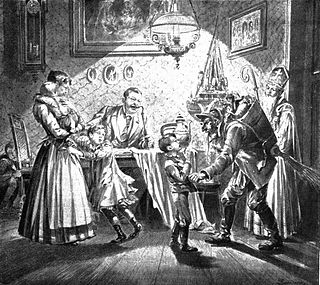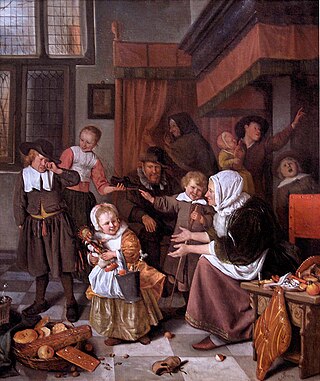
A postal code is a series of letters or digits or both, sometimes including spaces or punctuation, included in a postal address for the purpose of sorting mail.

Belgian cuisine is widely varied with significant regional variations, while also reflecting the cuisines of neighbouring France, Germany and the Netherlands. It is sometimes said that Belgian food is served in the quantity of German cuisine but with the quality of French food. Outside the country, Belgium is best known for its chocolate, waffles, fries and beer.
Sinterklaas or Sint-Nicolaas is a legendary figure based on Saint Nicholas, patron saint of children. Other Dutch names for the figure include De Sint, De Goede Sint and De Goedheiligman. Many descendants and cognates of "Sinterklaas" or "Saint Nicholas" in other languages are also used in the Low Countries, nearby regions, and former Dutch colonies.

The companions of Saint Nicholas are a group of closely related figures who accompany Saint Nicholas throughout the territories formerly in the Holy Roman Empire or the countries that it influenced culturally. These characters act as a foil to the benevolent Christmas gift-bringer, threatening to thrash or abduct disobedient children. Jacob Grimm associated this character with the pre-Christian house spirit which could be benevolent or malicious, but whose mischievous side was emphasized after Christianization. The association of the Christmas gift-bringer with elves has parallels in English and Scandinavian folklore, and is ultimately and remotely connected to the Christmas elf in modern American folklore.

Saint Nicholas Day, also called the Feast of Saint Nicholas, observed on 5 December or on 6 December in Western Christian countries, and on 19 December in Eastern Christian countries using the old church Calendar, is the feast day of Saint Nicholas of Myra; it falls within the season of Advent. It is celebrated as a Christian festival with particular regard to Saint Nicholas' reputation as a bringer of gifts, as well as through the attendance of church services.
The national holidays in the Netherlands are:
Dutch cuisine is formed from the cooking traditions and practices of the Netherlands. The country's cuisine is shaped by its location in the fertile North Sea river delta of the European Plain, giving rise to fishing, farming and overseas trade. The Burgundian-Habsburg court and the colonial spice trade enriched the cuisine of the elite in the 16th and 17th century.

Impact is a sans-serif typeface in the industrial or grotesk style designed by Geoffrey Lee in 1965 and released by the Stephenson Blake foundry of Sheffield. It is well known for having been included in the core fonts for the Web package and distributed with Microsoft Windows since Windows 98. In the 2010s, it gained popularity for its use in image macros and other internet memes.

Pfeffernüsse are small spice cookies, popular as a holiday treat with Germans and ethnic Mennonites in North America. Similar cookies are made in Denmark, and The Netherlands, as well. They are called Pfeffernüsse in German, pepernoten in Dutch, päpanät in Plautdietsch, pfeffernusse or peppernuts in English, and pebernødder in Danish.

Santa Claus, also known as Father Christmas, Saint Nicholas, Saint Nick, Kris Kringle, or simply Santa, is a legendary figure originating in Western Christian culture who is said to bring gifts during the late evening and overnight hours on Christmas Eve to "nice" children, and either coal or nothing to "naughty" children. He is said to accomplish this with the aid of Christmas elves, who make the toys in his North Pole workshop, and with the aid of flying reindeer who pull his sleigh through the air.

Saint Nicholas is a legendary figure in European folklore based on Greek early Christian and bishop Nicholas of Myra, patron saint of children.

Belgian chocolate is chocolate produced in Belgium. A major industry since the 19th century, today it forms an important part of the nation's economy and culture.

Below are some of common festivities associated with, or observed by the Dutch ethnic group. Included are cultural feasts. National holidays, of for example the Netherlands are omitted. Major festivities include:

Kruidnoten are hard cookie-like confectioneries made of speculaas, roughly the size of a coin and shaped as a flattened hemisphere, traditionally associated with Sinterklaas and consequently commonly eaten in Belgium and the Netherlands.

Zwarte Piet, also known in English by the translated name Black Pete, is the companion of Saint Nicholas in the folklore of the Low Countries. The earliest known illustration of the character comes from an 1850 book by Amsterdam schoolteacher Jan Schenkman in which he was depicted as a black Moor from Spain.

Sint is a 2010 Dutch dark comedy horror film about Sinterklaas, the character on which the Anglo-Saxon Santa Claus is based. The film was directed by Dick Maas and marked his return to the horror genre, in which he gained acclaim with his debut De Lift (1983) and Amsterdamned (1988). The story distorts the popular traditions of Sinterklaas and portrays him as a ghost who murders large numbers of people when his annual celebration night coincides with a full moon.

Open Sans is an open source humanist sans-serif typeface designed by Steve Matteson, commissioned by Google and released in 2011. It is based on his previous Droid Sans design, designed for Android mobile devices, but slightly wider.

Kue semprong, Asian egg roll, sapit, sepit, kue Belanda, or kapit, is an Indonesian traditional wafer snack made by clasping egg batter using an iron mold which is heated up on a charcoal stove. It is commonly found in Indonesia, Malaysia, Singapore and Brunei.

Christmas traditions include a variety of customs, religious practices, rituals, and folklore associated with the celebration of Christmas. Many of these traditions vary by country or region, while others are practiced in a virtually identical manner across the world.

Kick Out Zwarte Piet (KOZP) is a Dutch activist organization that campaigns against the Zwarte Piet character in the culture of the Low Countries. Zwarte Piet is traditionally part of the annual Christian feast of Sinterklaasavond in the Netherlands, Belgium and the Dutch diaspora on the evening of 5 December in the Netherlands and 6 December in Belgium. Saint Nicholas Day is also celebrated in the Balkans, Eastern Europe, Central Europe and the Middle East. In the folklore of the Low Countries, Zwarte Piet is portrayed as the dark-skinned Spanish Moor companion to Sinterklaas.

















